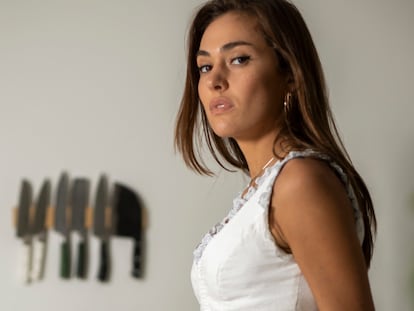When it comes to cakes, cheese please!
Tourists and foodies from all over the world are flocking to Spanish bars, restaurants and bakeries for a slice. An inside look at one of the most unexpected gastronomic phenomena of recent times
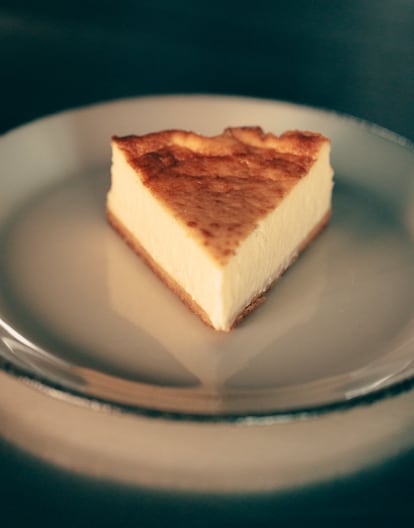
It’s 5pm on a Saturday. At No. 60 on Madrid’s Calle de Velázquez, a line snakes to the corner, doubles back and occasionally obstructs the crosswalk. Its integrants’ object of desire is Alex Cordobés’ cheesecake, and they’ve come from all over the world for a taste. We spoke with some of them, hailing from Greece and Qatar, Murcia and Miami — and even a few local Madrileños. Nearly all of them follow the same protocol, recording themselves in line and upon getting their hands on the cake, recording themselves again tasting it, offering a thumb’s up to the camera and in so doing, registering themselves as members of the same pastry community.

This cheesecake is no mere dessert. It’s “an explosion of the senses,” “a long and sublime bite,” “an inspiration.” Trying it has become “an experience,” à la any worthwhile 2024 experience. It’s not hard to see that a shift has taken place when such language and serious tone are being used to describe a cake’s ingredients and texture. Not to mention, when you see the investment and time spent on tasting the market’s most hyped models. The miles traveled, the lines braved to procure a limited edition.
If we were to assign a date to the beginning of cheesecake hype, it would be the day in 2021 that The New York Times proclaimed the La Viña edition as the “flavor of the year.” The announcement turned this pintxos bar in the old quarter of San Sebastián that first opened its doors in 1959 into a pilgrimage site akin to Lourdes in France or Fátima in Portugal. The cake in question was created by Santiago Rivera, owner of La Viña, who told Agencia Efe he spent months on a trial-and-error baking process, egged on by his father Eladio, the restaurant’s founder. “If you’ve done one thing well, son…,” were something like his progenitor’s words at the time. The resulting cheesecake is now the talk of the town. Also on everyone’s lips is the offering from Zuberoa, which was created by Hilario Arbelaitz and served as inspiration for yet another creamy celebrity, the cheesecake at Madrid restaurant Fismuler.
According to Nino Redruello, the chef for La Ancha restaurant group, nine years ago, a month before Fismuler was set to open, he and nine new cooks and pastry chef Fernando Palacios set out to create “a star dessert” in a workshop in the Madrid neighborhood of Tetuán. “We had a cheesecake in mind, specifically, Zuberoa’s. We were a bit inspired by it, but we added our own style,” says Redruello. The kitchen on Calle de Cactus served as their laboratory: they baked one cake in the morning and another one in the afternoon, trying different amounts of cheese and baking temperatures. “We wanted to make a cake for cheese lovers, at the border of sweet and salty, and see if it were possible to safely sell a cake that was so under-cooked,” he recalls. Sixty cakes later, they got the results they were looking for, a recipe that has now gone unchanged for 10 years. “The cake does not need to be refrigerated, it is served warm. It gets its personality from the mix of smoked Idiazábal and blue cheese,” says the chef. The dessert landed like a bomb. Word quickly spread throughout Madrid that only a limited quantity of cakes were being baked each day. The rumors were true, and people began to reserve their table’s cake, or order it with their appetizers to ensure they got a slice. Redruello insists that “all of Spain” has copied the cake. “I don’t have a patent, but I’ll never spend so much time making a dessert again. Although I don’t mind if they copy me,” he claims.
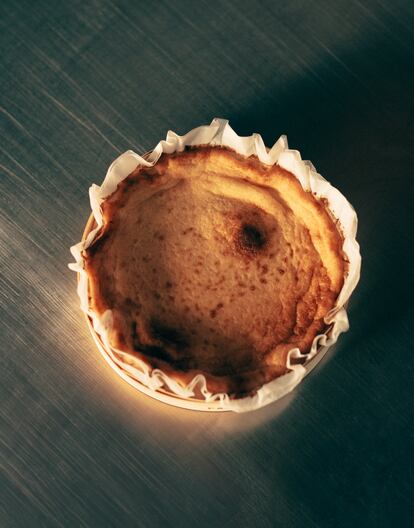
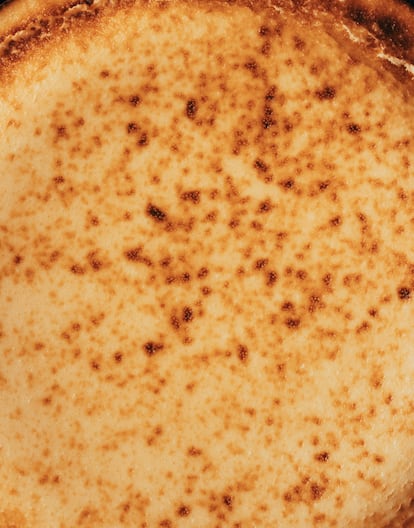
Seven years ago, when the father-son team of Javier Cocheteux Sr and Jr opened Pan.delirio, the makers of the roscón de reyes that was widely acknowledged to be the city’s best set out to make their own version of the cheesecake. They were inspired by the one made at La Viña. They hit upon a creamy formula that also featured smoked Idiazábal cheese “that is beat by hand and can wind up more or less baked,” says Javier junior. The uniqueness of their cake lies in a crust that is made with roscón flour, which they get by dehydrating a roscón de reyes — a popular New Year’s dessert — at 185ºC and pulverizing it. They calculate that they now sell 100 cakes a day.
In 2019, Cordobés baked his first cheesecake in the oven of his family home in Las Rozas, a town northwest of Madrid. The oven in question belonged to his parents, but he took it over on a full-time basis in pursuit of perfection. “I dreamed about cakes. I had a notebook and a blackboard and I baked cakes one by one,” he remembers. The electricity bill was frightful and his parents were suddenly unable to prepare their weekend dish of roast lamb or piglet. “I was obsessed with elevating the ingredients and finding small, expensive and exquisite suppliers. I spent a fortune on the best butter and another on farmer’s eggs. The same providers told me that my business plan was a disaster, I wasn’t even keeping track of the bills. I didn’t consider any other dessert. I was sure that the single product would be a hit, but only if I got to the perfect version,” says Cordobés. His business was “zero sustainable,” but every time he let his friends try his cake, he could tell from their reactions and “faces of happiness” that he was on the right track. Later, he offered tastings to foodies, chefs and gastronomic influencers, one of whom told him it was the best they’d tasted “in their life.” Cordobés began to sell cakes out of his parents’ house in 2019 and created an Instagram account. Word of the mouth of the cake, as it were, began to spread. One day, a famous soccer player shared it online, and then, a well-known chef. Cordobés baked to order and clients picked up the cakes at the family house in Las Rozas, whose address began to be widely circulated. The rest is history. Today, his shop bakes between 9,000 and 10,000 cakes every week, and its line of customers snakes around Calle de Velázquez. They always sell out.
If you’ve read this far, you might be asking yourself why so many people have gone crazy for cheesecake? The short answer is, they are in the throes of one of the great post-pandemic gastronomic crazes, a list that also includes specialty coffee, the smashburger, natural wine and the Basque Country’s beloved gildas, a tapa made with guindilla peppers, anchovies and olives and named after Rita Hayworth’s famous character.
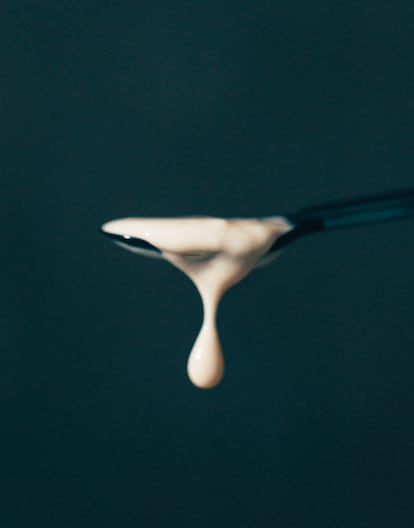
Alex de la Rosa, journalist, creator of the Instagram account @quenomeladenconqueso (63,000 followers) and dedicated observer of gastronomic trends, reveals the secret behind how such hype is created. “It’s usually businesses that focus on a single product, products that are often simple and accessible and that in the space of a single day, become impossible to get due to their price, limited editions or lines of customers that keep them constantly selling out. Demand takes off, and by the grace of social media, a product that once went unnoticed becomes an object of desire.” Mapi Hermida (@lagastronoma on Instagram, 66,500 followers) adds, “They are using two techniques: creating a connection with the audience through the recruitment of opinion leaders and influencers, or creating scarcity with the promotion of a product branded as artisanal and unique, not accessible to everyone, that you have to wait in a line to try.”
Such crazes often have short lifespans — but the allure of some legendary cheesecakes has endured decades. “Good things last, even if they’re born as hype,” reflects De la Rosa, who thinks that people “aren’t stupid,” even when they let themselves get swept up in internet phenomena. “They know what is good and what isn’t,” he says. Cheesecakes are decidedly good. And they’ll likely still be here when Instagram is long gone.
Sign up for our weekly newsletter to get more English-language news coverage from EL PAÍS USA Edition
Tu suscripción se está usando en otro dispositivo
¿Quieres añadir otro usuario a tu suscripción?
Si continúas leyendo en este dispositivo, no se podrá leer en el otro.
FlechaTu suscripción se está usando en otro dispositivo y solo puedes acceder a EL PAÍS desde un dispositivo a la vez.
Si quieres compartir tu cuenta, cambia tu suscripción a la modalidad Premium, así podrás añadir otro usuario. Cada uno accederá con su propia cuenta de email, lo que os permitirá personalizar vuestra experiencia en EL PAÍS.
¿Tienes una suscripción de empresa? Accede aquí para contratar más cuentas.
En el caso de no saber quién está usando tu cuenta, te recomendamos cambiar tu contraseña aquí.
Si decides continuar compartiendo tu cuenta, este mensaje se mostrará en tu dispositivo y en el de la otra persona que está usando tu cuenta de forma indefinida, afectando a tu experiencia de lectura. Puedes consultar aquí los términos y condiciones de la suscripción digital.
More information
Archived In
Últimas noticias
The complicated life of Francesca Albanese: A rising figure in Italy but barred from every bank by Trump’s sanctions
How Japan is trying to avert ‘digital defeat’
Half of Scotland is in the hands of 420 property owners
Reinhard Genzel, Nobel laureate in physics: ‘One-minute videos will never give you the truth’
Most viewed
- Pablo Escobar’s hippos: A serious environmental problem, 40 years on
- Reinhard Genzel, Nobel laureate in physics: ‘One-minute videos will never give you the truth’
- Why we lost the habit of sleeping in two segments and how that changed our sense of time
- Charles Dubouloz, mountaineering star, retires at 36 with a farewell tour inspired by Walter Bonatti
- The Florida Keys tourist paradise is besieged by immigration agents: ‘We’ve never seen anything like this’


